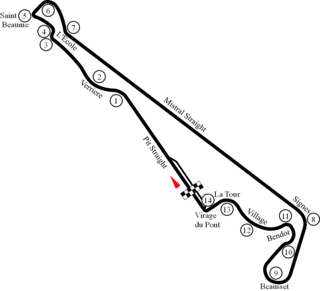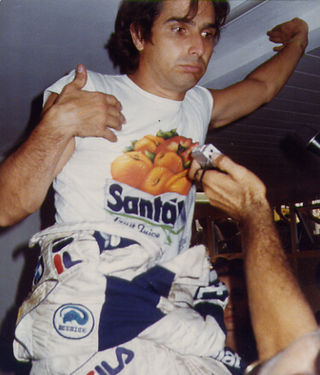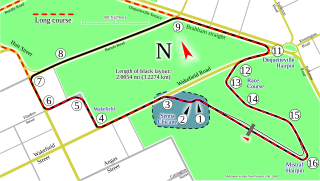
The 1985 French Grand Prix was a Formula One motor race held at Paul Ricard on 7 July 1985. It was the seventh race of the 1985 Formula One World Championship. It was the 63rd French Grand Prix and the ninth to be held at Paul Ricard. The race was held over 53 laps of the 5.81-kilometre (3.61 mi) circuit for a total race distance of 307.93 kilometres (191.34 mi).

The 1985 European Grand Prix was a Formula One motor race held at Brands Hatch on 6 October 1985. It was the fourteenth race of the 1985 Formula One World Championship.

The 1986 Belgian Grand Prix was a Formula One motor race held at the Circuit de Spa-Francorchamps on 25 May 1986. It was the fifth race of the 1986 FIA Formula One World Championship. The race was the 44th Belgian Grand Prix and the 32nd to be held at Spa-Francorchamps. It was held over 43 laps of the 7-kilometre (4.35 mi) circuit for a total race distance of 301 kilometres (187 mi).

The 1986 Australian Grand Prix was a Formula One motor race held on 26 October 1986 at the Adelaide Street Circuit, Adelaide, Australia. It was the sixteenth and final race of the 1986 Formula One World Championship. The race decided a three-way battle for the Drivers' Championship between Brit Nigel Mansell, driving a Williams-Honda; his Brazilian teammate Nelson Piquet; and Frenchman Alain Prost, driving a McLaren-TAG.

The 1988 Brazilian Grand Prix was a Formula One motor race held on April 3, 1988, at the renamed Autódromo Internacional Nelson Piquet in Rio de Janeiro. Following his 3rd World Drivers' Championship in 1987 the Jacarepaguá Circuit was named after local hero Nelson Piquet. It was the first race of the 1988 Formula One season.

The 1988 San Marino Grand Prix was a Formula One motor race held at Imola on 1 May 1988. The 60-lap race was the second round of the 1988 Formula One season. Ayrton Senna scored his first victory for the McLaren team, with turbocharged Honda-powered cars sweeping the top three positions.

The 1988 Australian Grand Prix was a Formula One motor race held at the Adelaide Street Circuit on 13 November 1988. It was the sixteenth and final race of the 1988 Formula One World Championship, and the last race for which turbocharged engines would be eligible until the 2014 Australian Grand Prix.

The 1988 FIA Formula One World Championship was the 42nd season of FIA Formula One motor racing. It featured the 1988 Formula One World Championship for Drivers and the 1988 Formula One World Championship for Constructors, which were contested concurrently over a sixteen-race series that commenced on 3 April and ended on 13 November. The World Championship for Drivers was won by Ayrton Senna, and the World Championship for Constructors by McLaren-Honda. Senna and McLaren teammate Alain Prost won fifteen of the sixteen races between them; the only race neither driver won was the Italian Grand Prix, where Ferrari's Gerhard Berger took an emotional victory four weeks after the death of team founder Enzo Ferrari. McLaren's win tally has only been bettered or equalled in seasons with more than sixteen races; their Constructors' Championship tally of 199 points, more than three times that of any other constructor, was also a record until 2002.

The 1987 FIA Formula One World Championship was the 41st season of FIA Formula One motor racing. It featured the 1987 Formula One World Championship for Drivers and the 1987 Formula One World Championship for Constructors, which were contested concurrently over a sixteen-race series that commenced on 12 April and ended on 15 November.

The 1986 FIA Formula One World Championship was the 40th season of FIA Formula One motor racing. It featured the 1986 Formula One World Championship for Drivers and the 1986 Formula One World Championship for Manufacturers, both of which commenced on 23 March and ended on 26 October after sixteen races. The Drivers' Championship was won by Alain Prost, Prost was the first driver to win back-to-back Drivers' Championships since Jack Brabham in 1959 and 1960. Together with Prost, Nigel Mansell, Nelson Piquet and Ayrton Senna dominated throughout the season and formed what was dubbed as the "Gang of Four".

The 1985 FIA Formula One World Championship was the 39th season of FIA Formula One motor racing. It featured the 1985 Formula One World Championship for Drivers and the 1985 Formula One World Championship for Manufacturers, both of which commenced on 7 April and ended on 3 November after sixteen races.

The 1983 FIA Formula One World Championship was the 37th season of FIA Formula One motor racing. It featured the 1983 Formula One World Championship for Drivers and the 1983 Formula One World Championship for Manufacturers, which were contested concurrently over a fifteen-race series that commenced on 13 March and ended on 15 October.

The Autódromo Internacional Nelson Piquet, also known as Jacarepaguá after the neighbourhood in which it was located, and also as the Autódromo Riocentro, was a motorsport circuit in Rio de Janeiro, Brazil. Opened in January 1978, a few weeks before 1978 Brazilian Grand Prix, it hosted the Formula One Brazilian Grand Prix on ten occasions, and was also used for CART, motorcycle racing and stock car racing. In 2012, it was demolished to make way for facilities to be used at the 2016 Summer Olympics.

The Adelaide Street Circuit is a temporary street circuit in the East Parklands adjacent to the Adelaide central business district in South Australia, Australia.
The Japanese automobile manufacturer Honda has participated in Formula One, as an engine manufacturer and team owner, for various periods since 1964. Honda's involvement in Formula One began as a full team and engine entry in the 1964 season, and in 1965 they achieved their first victory at the Mexican Grand Prix. After further success with John Surtees, Honda withdrew at the end of the 1968 season due to difficulties selling road cars in the United States and Honda driver Jo Schlesser's fatal accident.

The McLaren MP4/4, also known as the McLaren-Honda MP4/4, is one of the most successful Formula One car designs of all time. Powered by Honda's RA168E 1.5-litre V6-turbo engine and driven by teammates Alain Prost and Ayrton Senna, the car competed during the 1988 Formula One season. The design of the car was led by American engineer Steve Nichols, the full responsibility for the design of the chassis having been conferred on him by Ron Dennis. Gordon Murray, as Technical Director, had the role of liaising between the drawing office and production.

The Lotus 97T was a Formula One racing car designed by Gérard Ducarouge and built by Team Lotus for use in the 1985 Formula One World Championship. A development of the previous year's 95T, the car was powered by the turbocharged 1.5-litre Renault EF15B V6 engine and ran on Goodyear tyres. John Player Special continued as the team's title sponsor, with Elf and Olympus as secondary sponsors.

The McLaren MP4/2 was a Formula One car produced by McLaren for the 1984 season. An iteration of it, the MP4/2B, was used in the 1985 season, and a slightly updated version, the MP4/2C, raced in the 1986 season for McLaren. It was closely based on the MP4/1E model that was used as a test car, used in the final races of 1983.

The Williams FW11 was a Formula One car designed by Frank Dernie as a serious challenger to McLaren and their MP4/2C car. The car took over from where the FW10 left off at the end of 1985, when that car won the last three races of the season.

The Williams FW12 was a Formula One racing car used by the Williams team for the 1988 season. An updated version, the FW12C, was used for 12 of the 16 races of the 1989 season. The FW12 was Williams's first naturally aspirated car since the FW08 and FW08C used in the 1982 and 1983 season.


















